Highlights Along the Yellow River
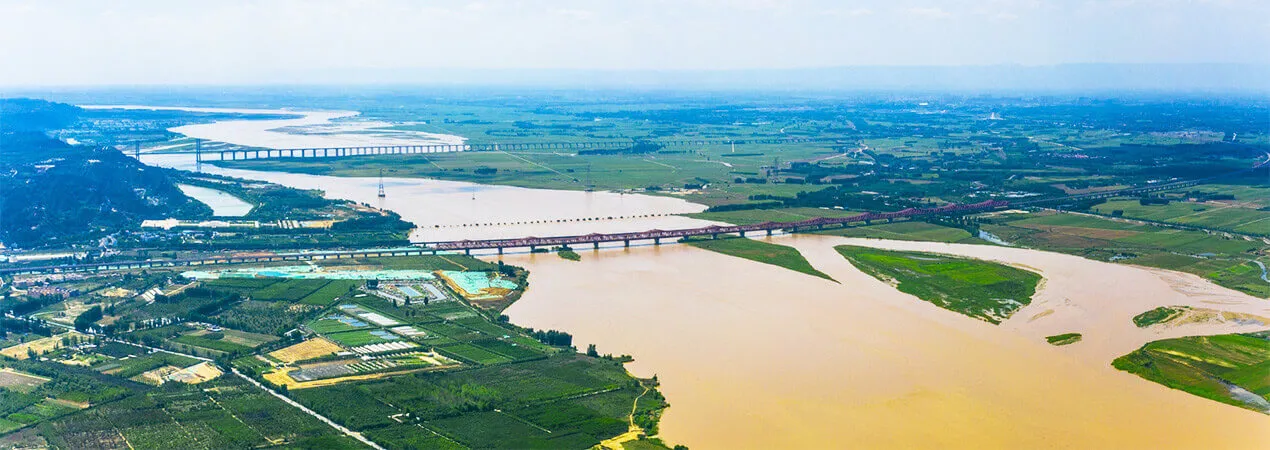
At 5,464km in length, the Yellow River runs from its lofty source on the Qinghai-Tibetan plateau, winds through 9 provinces, and empties into the Bohai Sea. It is China’s second-longest waterway after the Yangtze River, and the sixth longest in the world. It has created some of China’s most distinctive landscapes, barreling past colossal sand dunes before sliding along pancake-flat loess plains scarred with deep, winding crevasses. The steep canyons, waterfalls, deserts and grasslands make the natural landscape of the Yellow River basin magnificent and beautiful. The basin also has many cultural relics. Along the river’s path, there are 20 World Heritage Sites, more than 300,000 non-movable cultural relics, 649 national intangible cultural heritages, 47 national holistic tourism demonstration areas and 84 national top-rated tourist attractions. We have listed 10 of the most beautiful attractions along the Yellow River; most of them are off-the-beaten-track spots.
1. Sanjiangyuan (Three Rivers Source) National Park in Yushu County, Qinghai Province in Western China
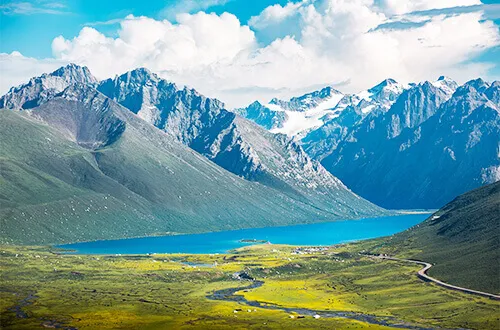
Sanjiangyuan means “source of three rivers”, referring to the area’s status as the headwaters of the powerful Yellow, Yangtze, and Lancang (Mekong) rivers. Fifteen percent of the Lancang’s water discharge, 25 percent of the Yangtze’s, and 49 percent of the Yellow’s originate here. It is China’s first and largest national park, covering a total area of 123,100 square kilometers and is the world's highest nature reserve, with an average altitude of 4,700 meters.
Featuring a typical Qinghai-Tibet Plateau ecosystem, Sanjiangyuan is rich in wildlife and has the highest biodiversity of any high-altitude area in the world. The national park is home to 760 vascular plant species, 59 bird species, 15 fish species, and 125 wild mammal species. There are vast wetlands, high mountains, glaciers and roaring rivers. The Sanjiangyuan National Park is expected to become a role model of eco-protection, innovative mechanism and modernization for all national parks in China.
2. The First Bend of the Yellow River at Tangke Town of Southwest China's Sichuan province
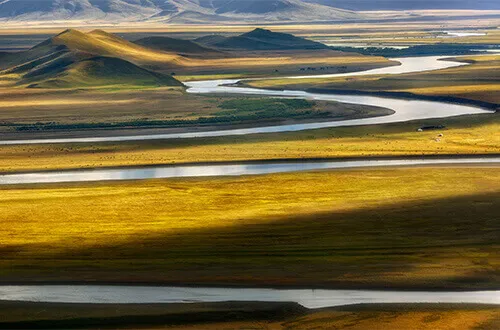
The first bend of the Yellow River is located at Tangke town in the northwestern plateau of southwest China's Sichuan province. After plunging through the Bayankela Valley, the Yellow River slows down and takes a huge turn between Mount Animaze and Mount Xize. The turn is 443 kilometers long, and is a natural boundary between Sichuan province and Gansu Province. The bend is surrounded by 30,000sqkm of Ruoergai grassland. The scenic area is around 3500 meters above sea level. A viewing platform has been built on a nearby hill top; you can take the escalator to the platform to have a good view of the bend. The best time to visit the bend is in the late afternoon. When the night comes slowly and the sky is full of the sunset, the scenery will be intoxicating.
Below the viewing platform, at the foot of the hill, there is a monastery called Suoke Tibetan Monastery. It was first built in 1658, and you can have a short tour there.
Due to its high altitude, the best time to visit the bend area is in summer from June to August. The grassland is green, and the horses and yaks are grazing on the lush grass.
3. Xiangshawan Desert (Singing Sand Ravine) in Ordos City, Inner Mongolia
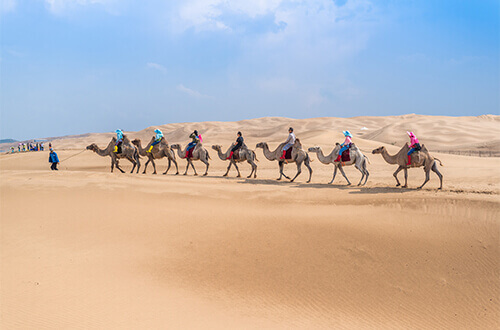
Xiangshawan Desert (Singing Sand Ravine) is in the Kubuqi Desert, a small section of the Gobi Desert about 50km from Ordos. It is 110 meters high with a slope of 45 degrees where the huge crescent-shaped sand hills can create loud echoes. Dunes stand side-by-side and stretch endlessly to the further skyline. When you climb to the top with a ladder and then slide down, you will hear roaring echoes as if an aircraft is taking off near you. If you hold a handful of sand and squeeze it, you will make a frog-like sound. This is how Singing Sand Ravine got its name. Nowadays in the desert is actually a huge resort complex. If you wander in deep enough, you'll find yurts and pools, playgrounds and hotels that really liven up in the high season (May to September).
4. Three Gorges of the Yellow River in Yongjing County, Northwestern China's Gansu Province
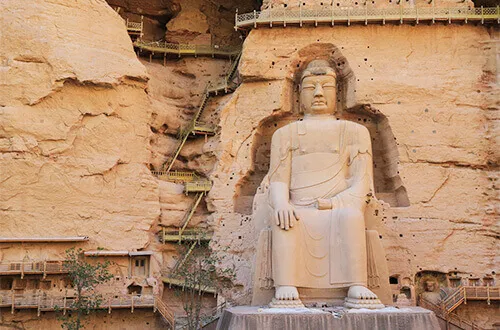
Bingling Temple Grottoes
Located in Yongjing County in Gansu Province, the three gorges are Bingling Gorge, Liujia Gorge and Yanguo Gorge. They are not as famous as their counterparts on the Yangtze River, but they are hidden gems for visitors. The scenic area boasts a variety of natural scenery as well as of cultural relics, including the Stone Forest of Bingling, the Liujia Gorge Reservoir, the Dinosaur National Geopark, the Bingling Temple Grottoes, and Taiji Lake.
Bingling Temple Grottoes are a complex of caves into which Buddhist statues and murals have been carved over hundreds of years. The carving began in 420 CE and was added to until the 17th century. It was added to the UNESCO World Heritage list in 2014.
In the Liujiaxia Dinosaur National Geopark, there are 71 two-toed imprints left behind by the feet of an Early Cretaceous dinosaur. Two-toed tracks have been found at numerous sites all over the world, but most of them are in China. This set of footprints was so unique, though, that they were given their own name.
5. Shapotou Desert in Zhongwei Ningxia Hui Autonomous Region
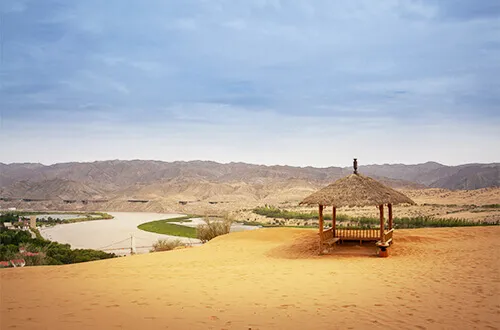
Shapotou Desert is located on the northern bank of the Yellow River where the southeastern section of the Tengger Desert borders Zhongwei. The mixture of water and desert makes it an aesthetic wonderland. The sunset on the Yellow River and sunrise in the desert are particularly memorable. It was voted as one of the five most beautiful deserts in China by Chinese National Geographic magazine.
With many different ways to explore the vast stretches of sand, Shapotou is the perfect place for those seeking a desert adventure. On board a modified 4x4 or amphibious vehicle, you can "surf" across the desert. Or you can choose to zip line over the yellow river on the 300 meter zip line, go bungee jumping, take a sled ride down a 150 foot sand dune, float down the yellow river on a raft made of an inflated sheep hide, and visit a small natural history Museum that includes details on how the Chinese were able to build a railroad through the sand dunes in the 1950s.
6. Hukou Waterfall at the Border Between Shanxi Province and Sha’anxi Province
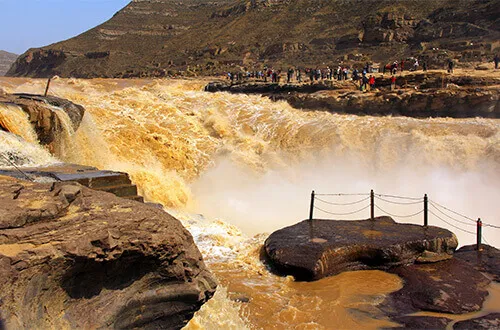
As China’s second largest waterfall and the largest one on the Yellow River, the Hukou Waterfall is noted for its yellow waters. It is the world’s largest yellow waterfall. The Hukou Waterfall is located at the border between the two provinces of Shanxi and Sha’anxi. The 300-meter wide Yellow River suddenly narrows and is forced violently through a 20-meter-wide gorge before falling turbulently as a waterfall. The roaring waters then plunge over a narrow opening on a cliff, forming a waterfall about 20 meters tall. The shape of the section of the river gives the waterfall its name ‘Hukou’, which means 'the mouth of a kettle'. The width of the waterfall varies with the season between 50 meters (164 feet) and 30 meters (98 feet).
Thousands of tourists come to see this waterfall and experience its thundering roar, especially during the floods when the waterfall is at its mightiest. The best time to see the flood is in April to May and September to October. It also enjoys spectacular views in winter when its banks completely freeze in cold weather in December and January. Visitors flock to marvel at the natural wonder after temperatures have plummeted to sub-zero.
7. Qiankunwan River Bend Along the Yellow River in Yonghe County, Shanxi Province
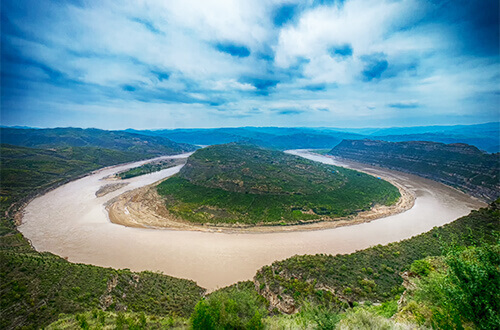
The Yellow River traverses Shanxi province in northern China, making a giant S-turn at Qiankunwan in Yonghe County before flowing southward. As the old saying goes “Of the 99 Bends of the Yellow River, Qiankunwan bend is the most beautiful one”. The bend is like a larger version of the Horseshoe Bend in the Grand Canyon in the United States. This section of the park is named Qiankunwan, which means "river bend of heaven and earth", alluding to the fact that the S-shaped bend resembles the Taijitu or symbol of Yin and Yang – the Chinese philosophical theory which suggests that heaven is yang and earth is yin. The river is surrounded by lush forest-covered mountains and hills. Thanks to the decades-long greening campaign, the bend area is surrounded by lush forest-covered mountains and hills. You can go rafting down the Yellow River.
8. Yuntaishan World Geopark at Jiaozuo City in the Henan Province of Central China
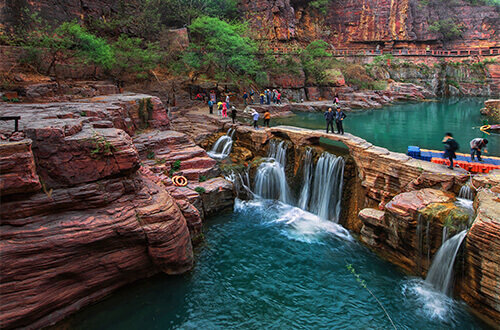
Yuntaishan, or Mt. Yuntai, is located in Xiuwu County, Jiaozuo City, Henan Province, 70km away from Zhengzhou City, the provincial capital. With an area of 280 sq km, in the southern foothills of Taihangshan Mountains, the park comprises of gorges cut through the age old red rock, high waterfalls and stunning mountain scenery. The highlights of the Geopark include:
Hongshi (Red Stone) Gorge – it is a gorge nestled beneath steep red sandstone cliffs that date back 1.4 billion years. A walkway will take you through the cliffs and down to the jade-green river.
Tanpu Gorge – the Gorge is a truly wondrous part of the park with towering cliffs and mountains surrounding you in every direction as the river splashes and gurgles beside you. Wanshan Temple – originally built during the Ming Dynasty, Wanshan Temple is a haven of tranquility in an already tranquil setting. There is a vegetarian restaurant situated in the temple providing both guests and resident monks with vegetarian meals.
If you are an aficionado of Taijiquan (Tai Chi Boxing), you should not miss Xiaozhai valley, where you can find a Taijiquan performance. The birth place of Chen Style Taijiquan Chenjiagou (Chen’s village) is just 70km (43miles) away. Chen Style Taijiquan is the oldest form of Taijiquan from which all other styles were created.
9. Xiaolangdi Dam in Luoyang Henan Province
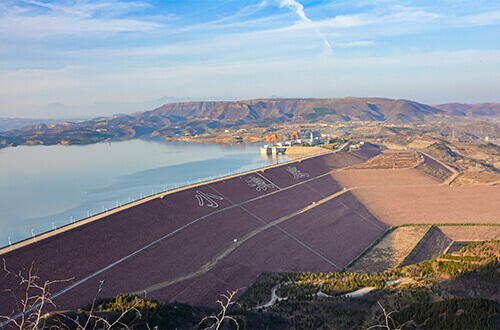
The Xiaolangdi Dam is located about 20km to the northwest of Luoyang. The project is the largest of its kind on the Yellow River, and is second only to the Three Gorges project on the Yangtze. It consists of underground generating units, silt-discharge channels, and a 1,317m-long, 154m-high dam. Xiaolangdi is a multi-purpose project for flood control, ice control, dredging, industrial and municipal water supply, and hydroelectric power. A complex system of 15 large tunnels with an underground powerhouse makes it possible to flush sediments by creating controlled floods in the main river channel. The precautionary purging at the Xiaolangdi Dam has occurred annually since 2002. At the end of June and the start of July each year, for as long as two weeks before the flood season, the dam authority will open silt-discharge tunnels , releasing clear and muddy water simultaneously from the reservoir above to the river below.
10. The Yellow River Delta National Nature Reserve in Dongying, Shandong Province
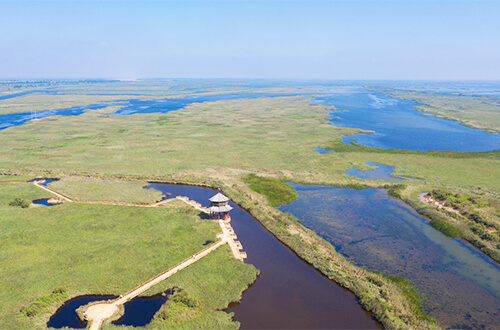
Founded in 1992, just after China became a member of the Ramsar Convention on wetland conservation, the reserve focuses on protecting the ecosystem in the Yellow River Estuary, in particular the rare and endangered birds that live there. The reserve is an almost naturally intact estuary wetland composed of shallow estuarine waters, tidal flats, marshes, reed swamps, canals and drainage channels, and aquaculture ponds at the mouth of the Yellow River estuary. It covers an area of 153,000 hectares and boasts a wetland ecosystem that is the best protected, the widest, and the youngest in China’s warm temperate zone. The reserve is now home to 1,626 types of wild animals, including 368 kinds of birds. There are 12 species of birds in the top national protection class and 51 species in the second. It provides a safe haven for migrating birds flying across Siberia and the Pacific Ocean to and from China. The reserve abounds in vegetation, boasting 393 kinds of plants and plant coverage of 55.1 percent.

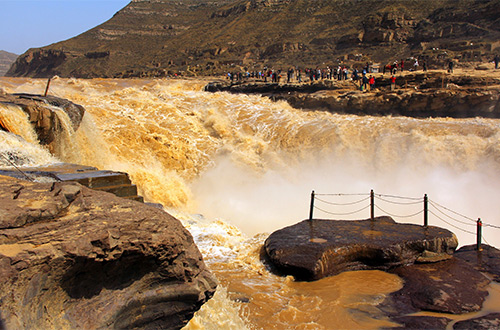 Yellow River Facts
Yellow River Facts  Poems About Yellow River
Poems About Yellow River 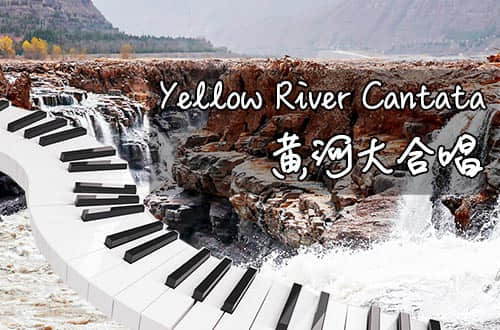 Songs About the Yellow River
Songs About the Yellow River 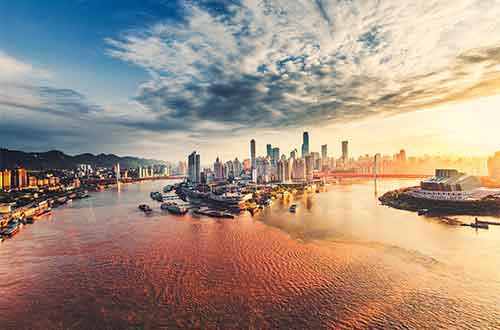 The Yangtze River
The Yangtze River